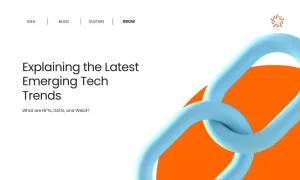- BlogTechnology Explaining the Latest Emerging Tech Trends: NFTs, DAOs and Web3




Explaining the Latest Emerging Tech Trends: NFTs, DAOs and Web3
Explaining the Latest Emerging Tech Trends: NFTs, DAOs, and Web3
According to Scientific Reports, “Overall, in the first four months of 2021, the NFT volume has exceeded 2 billion USD”. Recently there has been an increasing interest in NFTs, DAOs & Web3, and questions arise about how they might impact the tech landscape. One area that these emerging tech trends will undoubtedly impact is the online development landscape.
This article provides a non-technical description and a starting point to understanding some of these latest trends in technology.
NFTs
This first tech trend has caused quite the commotion within digital spaces – one common debate has been whether or not NFTs are the future of digital transformation. However, we must first understand what NFTs are to understand their impact on digital transformation.
NFTs (Non-fungible Tokens) are a unique and irreplaceable digital item. We store NFTs on a digital ledger (a blockchain), typically Ethereum. The blockchain also provides public proof of ownership.
NFTs typically represent digital ownership but can also be used for physical ownership. They differ from cryptocurrencies like Bitcoin as they are not mutually interchangeable in the same way that Bitcoin is. NFTs can be anything digital from photos to audio files.
Example:
NFTs can be used to provide an Ethereum web address with a memorable and uncomplicated name. Similar to an IP address simplified through the use of a website domain name. If you wanted to send currency (ETH) people can do so through a more commonplace name like myetherwallet.eth rather than 0x1234596789.
Web3
Web3 is the idea for the next stage of the internet, a decentralised version based on peer-to-peer technologies such as public blockchains. Explaining Web3 is easiest when we understand the versions of the web that precede it.
Web 1.0 refers to the period covering 1991 to 2004 where a large majority of internet users solely consumed content.
Web 2.0 or ‘The Social Web’ (roughly beginning in 2004) was the evolution into the web as a platform; the number of users producing content had started to outweigh the number of users consuming content. The production of content in this phase of the web covers social networking platforms, blogs, and video streaming websites. Web 2.0 is the version of the web that we are using at the moment, and the problems with web 2.0 are what web3 hopes to solve.
‘The Semantic web’ or web 3.0 as formulated by Ethereum co-founder Gavin Wood, has gathered a lot of attention. Whilst conversations have recently gained momentum, Web3 is a concept that has been around since 2001. This phase of the internet is the stage that is said to increase the internet’s intelligence to a level that is close to human intelligence, by harnessing the power of AI systems.
There are four key features of Web 3.0:
- Artificial Intelligence: Providing users with unbiased and filtered information tailored to each user’s liking.
- Ubiquity: Of a global, omnipresent capacity. Internet accessibility for everyone, anywhere and at any time.
- 3D Graphics: This feature focuses on the graphics technology revolution, bringing clarity to 3D virtual worlds.
- Semantic web: In this crucial feature, the focus is on applying semantics to the web, allowing for a machine’s ability to understand meaning and emotions through data analysis.
DAOs
DAOs (Decentralised Autonomous Organizations or Corporations) are organisations represented by rules encoded as a transparent computer program. The members of the organisation control the regulations without any governmental influence; no one can access them without group approval. Decentralised Autonomous Organizations are a safe way to work and collaborate with people worldwide.
DAOs resemble companies as they assemble people towards generating wealth and a mission. However, they use voluntary effort from members as opposed to a stream of income.
DAOs have different membership models:
- Share-based membership – open with some permission required, people who want to join can submit proposals offering valuable contributions e.g., MolochDAO.
- Token-based membership – permissionless trade on a decentralised exchange e.g., MakerDAO.
Example:
DAOs can be used in venture organisations by creating a venture fund that gathers any investment capital and then the establishment votes collectively on the ventures they wish to support. Once a decision is made, money that is repaid can then be redistributed amongst the members of the organisation.
Creating a Plan for Digital Transformation
New technologies have an impact on the software development landscape. For instance, any advancements in Web3 can mean that your software requirements will change. At Incepteo, we work to understand the many tools and technologies that will be best suited to your business, helping you to navigate the unknown.
Share this:
Recent Posts
By Sector

How Can Incepteo Help You?


Quick Links
AI SERVICES
2024 © All rights reserved by Incepteo

